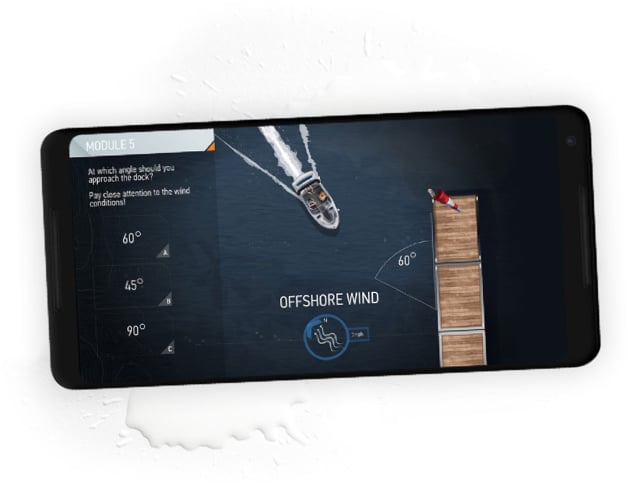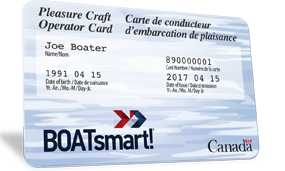
WHAT IS A PLEASURE CRAFT OPERATOR CARD?
A Pleasure Craft Operator Card, commonly referred to as Canadian Boating License, is a federal competency card, issued after the successful completion of an approved boating safety course and official Transport Canada Boating Safety Test. The Card proves that you have obtained the knowledge to safely operate a motorized pleasure craft on Canada’s waterways.
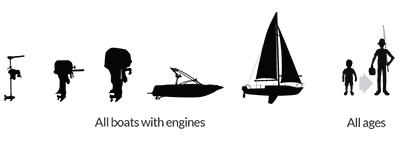
Boating License Operator Competency Laws
Who Needs It
All operators of motorized recreational vessels, including personal watercraft (PWCs), motorized sailboats, and small boats with electric trolling motors, are required to obtain a PCOC (boating license) or other proof of competency. The PCOC must be carried on board the boat at all times during operation. Photocopies are not accepted. Operators who are caught boating without the card will face a fine of $250.What is Proof of Competency
Proof of Competency is proof that you are certified to operate a recreational motorized boat in Canada. Proof of competency can take 3 forms:- A Pleasure Craft Operator Card issued following the successful completion of an accredited Transport Canada Boating Safety Test.
- Proof of having completed a boating safety course prior to April 1st, 1999, or having obtained an approved marine certificate.
- A completed rental boat safety checklist (required for operating a rented motorized boat)
Non-Canadian Boaters
Non-residents who are operating a non-Canadian registered vessel in Canada for up to 45 days do not require proof of competency. However, non-residents who operate a Canadian-registered vessel in Canada must carry proof of competency on board at all times. Proof of residency must also be carried on board during operation.Commercial Operators
Commercial mariners who hold valid recognized professional maritime certificates, such as Master Mariner, may choose to obtain a Pleasure Craft Operator Card to carry on board while operating a recreational motorized boat. However, obtaining a Pleasure Craft Operator Card is not required in this instance.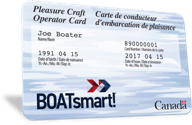
Canadian Boating License FAQs
What's the difference between a Canadian Boating License and a pleasure craft license?
A Canadian Boating License, or Pleasure Craft Operator Card, is a federal competency card issued following the successful completion of an accredited Transport Canada Boating Safety Test. A PCOC allows you to legally operate a motorized recreational boat in Canada. Although it is commonly referred to as a ‘license’ this is incorrect. A Pleasure Craft License is a document that contains a set of I.D. numbers. The document must be carried on board your boat at all times, and the numbers must be displayed on your boat for identification purposes. The number must be displayed on both sides of the bow, above the waterline, as far forward as possible, in block letters at least 7.5cm high that contrast with the colour of the boat. All motorized boats and PWCs in Canada powered by a motor of 10 hp or more are required to have a Pleasure Craft License. You can obtain a 10 year license for free from the Pleasure Craft Licensing Centre. The license is valid for a period of 10 years, beginning the day it was issued, transferred or renewed.
Where can I get a Canadian Boating License
Boaters can obtain their boating license by attaining a mark of at least 75 percent on a Transport Canada accredited Boating Safety Test. The test can be taken online with BOATsmart! after completing the online boating safety course. Boaters may also choose to challenge the exam in-person. There is no legal requirement to complete a boating safety course when completing an in-person exam.
How long does it take to get the card?
Upon successfully completing the Transport Canada Boating Safety Test, operators will immediately be issued a Temporary Pleasure Craft Operator Card, which is valid for 60 days from the test date. The permanent PCOC is then sent out by mail, and will arrive within 4 weeks.
Do I need a boating license to rent a boat?
Operators who plan to rent a motorized recreational boat in Canada are required to carry proof of competency on board during operation. Proof of competency may take the form of a PCOC (boating license), or a completed rental boat safety checklist. The completed checklist is valid only for the rental period and must be carried on board the boat at all times.
Can I get free boating lessons after taking the course?
Yes. Even after you pass the test and obtain your PCOC, you will always have access to free refresher lessons in your BOATsmart! Account. Login anytime to brush up on your boating safety knowledge to ensure that you’re safe and confident on the water. BOATsmart! also offers a free knowledge base containing boating safety information and regulations that apply across Canada and the United States.
Who Enforces Boating Laws & Regulations
The Royal Canadian Mounted Police (RCMP), provincial, and municipal police forces and other local authorities enforce Canada’s boating laws. Law enforcement officers may inspect your boat and monitor your activities at any time to ensure that you are in compliance with Canada’s boating laws.
Where can I boat with the PCOC?
The Pleasure Craft Operator Card allows Canadian boaters to operate a motorized pleasure craft on Canadian waterways, recreationally, where permitted.
Are these federal or provincial laws?
Federal law requires boat operators to obtain a Pleasure Craft Operator Card (boating license) or other proof of competency. These laws apply across all provinces.
Do I need a Canadian Boating License if I operate a boat for work purposes?
Boaters who operate a vessel for work purposes are typically required to obtain a higher level or marine safety certification however, this is not true in all cases. The type of certification required will vary depending on a variety of factors including the number of people on the vessel, and the purpose of the workboat (e.g. commercial fishing, tour boats etc.) In some instances a boating license may qualify as valid certification to operate a work boat. For more information on the different levels of marine certification visit the online Marine Training, Examination and Certification centre.
Do I need a driver’s license to operate a pleasure craft?
No. You are not required to obtain a driver’s license to operate a motorized recreational boat on Canadian waterways. However you must carry proof of competency, such as a Pleasure Craft Operator Card, on board your boat at all time during operation.
Is the PCOC valid in all provinces?
Yes. The PCOC is a federally mandated competency card that is valid in all Canadian provinces and territories. A PCOC that was obtained in one province is valid across Canada.
Why do boaters need a Canadian Boating License?
Boat operators in Canada are required to obtain a boating license (or other proof of competency) to ensure that they are able to safely operate a recreational boat on Canadian waters. The Competency of Operators Pleasure Craft Regulations, which require boat operators to obtain a PCOC, were enacted by the Canadian Coast Guard in an effort to reduce the number of boating-related accidents and fatalities on Canada’s waterways.
Are there exemptions?
As of September 15, 2009, all operators of recreational motorized boats are required to obtain proof of competency. There are no exemptions for age, horsepower, or boat length. These regulations also apply to indigenous people however they do not apply if the vessel is being used for daily living or subsistence activities (such as hunting and fishing practised by many Indigenous peoples).
Canadian Boating & Alcohol Laws
- Operating a boat anywhere in Canada while under the influence of alcohol and/or drugs.
- Operators a boat anywhere in Canada with a blood alcohol concentration (BAC) of 80 mg per 100 ml or 0.08 BAC.
- Failing or refusing to comply with a demand from an enforcement officer to submit a blood sample.
Age & Horsepower Restrictions

UNDER 12 YEARS OF AGE
Boaters who are less than 12 years of age who have proof of competency may operate a motorized boat, without supervision, so long as the engine is not more than 10 hp.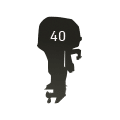
12 TO UNDER 16 YEARS OF AGE
Boat who are 12 to under 16 years of age who have proof of competency may operate a motorized boat, without supervision, as long as the engine is not more than 40 hp.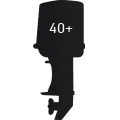
16 YEARS OF AGE AND OLDER
Operators who are 16 years of age or older may operate a motorized boat without supervision, including a PWC, as long as they have obtained proof of competency.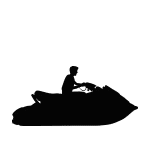
PWC AGE RESTRICTIONS
Operators who are less than 16 years of age are not permitted to operate a PWC under any conditions.
SUPERVISION PROVISIONS
Boat operators who require supervision under the Age and Horsepower Requirements must carry proof of competency on board the boat. The supervisor must be at least 16 years of age and must also have proof of competency. Operators who are less than 16 years of age may not operate a PWC, even if they are supervised.
Canada's Boating Fines
Failure to carry a Pleasure Craft Operator Card or proof of competency
$250 - $10,000
Violation of age and horsepower restrictions
$250 - $10,000
Insufficient number of Transport Canada-approved life jackets or PFDs
$200 Per Missing Device
Operating a PWC under 16 years of age
$100
Carrying open liquor on board
$200
Operating a vessel in an unsafe manner
$500
Travelling over 10 km/h within 30 meters of shore
$200
Boat Safety Equipment violations (depending on type of equipment)
$125 +
Failure to carry a fire extinguisher
$245
Failure to have a spotter on board during towed sports activities
$250
Failure to have enough seats to carry a person being towed
$250 per person
How do I Get a Boat License in Canada?
Do I Need a Pleasure Craft License?
All motorized boats and PWCs in Canada powered by a motor of 10 hp or more are required to have a Pleasure Craft License. A Pleasure Craft License is a document containing a set of ID numbers. The document must be carried on board the boat at all times, and the numbers must be displayed on the boat. The numbers must be on both sides of the bow, above the waterline, as far forward as possible, in block letters at least 7.5cm high that contrast with the colour of the boat.How do I get a Pleasure Craft License?
You can obtain a 10 year license for free from the Pleasure Craft Licensing Centre. The license is valid for a period of 10 years, beginning the day it was issued, transferred or renewed. You can obtain the license in one of two ways: Option 1: Apply for a free Pleasure Craft License online. Option 2: Download a paper application form and mail the completed form to the Pleasure Craft Licensing Centre at the following address: Pleasure Craft Licensing Centre P.O. Box 2006 Fredericton, New Brunswick E3B 5G4Buying a new or used boat in Canada
Buying a boat in Canada? Whether it’s a brand new boat from a dealership or a used vessel, you’re required to obtain a Pleasure Craft License. You are also required by law to ensure you carry onboard all of the required boating safety equipment for the type and size of the vessel.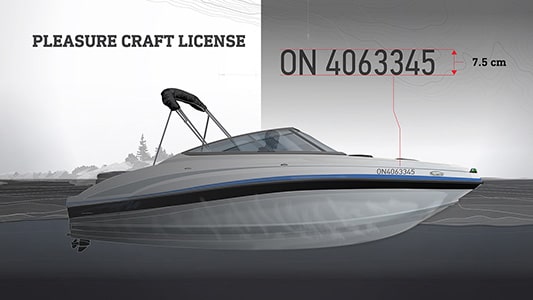
Registering your Boat
Registering your boat is different than obtaining a Pleasure Craft License. Unlike a Pleasure Craft License, Vessel Registration provides proof of ownership. Upon registering your boat, you’ll receive proof of ownership, a unique name, and an official number for your boat, in addition to the right to use your boat as security for a marine mortgage. There are costs involved in registering your boat, but if you plan on traveling in international waters, it is commended. For more information on boat licensing and registration visit www.boatingsafety.tc.gc.caDO I NEED BOAT INSURANCE?
No, boat owners are not required to have boat insurance in Canada. However, there are benefits to insuring your boat including 3rd party liability, replacement and accidental damage coverage. Boaters who obtain their license with BOATsmart! automatically qualify to save on boating insurance.Life Jackets and Personal Flotation Devices
Approved flotation devices
Statistics show that most small boat operators who drowned were in sight of a potential rescuer, and would likely have been saved if they had just remained afloat a few moments longer. Always wear your life jacket! By wearing a Canadian-approved, properly fitted flotation device you will greatly reduce your risk of accidental drowning! There are three main types of Canadian-approved flotation devices:
- Life jackets
- Personal Flotation Devices (PFDs)
- Inflatable PFDs
How do I know if my life jacket is Canadian-approved
Canadian-approved flotation devices have a label or stamp indicating that they are approved by Transport Canada or the Canadian Coast Guard. If the flotation device has been damaged, altered, or repaired, or if the label or stamp indicating approval is illegible, the flotation device will no longer be considered approved. If the flotation device is ripped or damaged, replace it immediately. Be aware that not all PFDs are Canadian-approved (like some wakeboard vests). Always check the label!
Life Jackets
Boat operators can choose between wearing a life jacket or PFD, but should keep in mind that life jackets offer a higher level of protection.
In Canada, there are three styles of approved life jackets available, including:- Safety of Life at Sea (SOLAS) Life Jackets, which offer the best performance and will turn an unconscious person face-up, and out of the water, in seconds.
- Standard Life Jackets, which provide a high level of buoyancy, and will turn an unconscious person face-up and out of the water, but are often less comfortable.
- Small Vessel Life Jackets, which are also designed to turn an unconscious person face-up and out of the water, but are less buoyant than other life jacket types and have less turning ability.
Personal Flotation Devices
Personal Flotation Devices (PFDs) are more comfortable and less restrictive than life jackets, however they are designed to keep a person afloat but are NOT designed to turn an unconscious person face-up in the water.
Choosing the right Life Jacket
When choosing a life jacket or PFD, you should consider the following:
- Check the label or stamp to confirm that the flotation device is Canadian-approved
- Choose one that suits the type of boating activities you will be doing. Will you be wakeboarding? Operating a PWC? Fishing?
- Verify that the life jacket or PFD is appropriate for your size and weight- It should fit snugly but allow for freedom of movement
- If you’re purchasing a life jacket or PFD for another person, you need to be sure that it will fit them properly.
Children's Life Jackets
Children should wear a life jacket or PFD at all times, both on the boat and when they are near the water. When selecting a life jacket for a child, always choose one that has been specifically designed for children, and that fits the child properly. A children’s life jacket or PFD should have the following features:
- A label or stamp indicating that it is Canadian-approved
- An extra-large collar to support the child’s head
- A safety strap that fastens between the legs, to prevent the jacket from slipping over the child’s head
- A grab strap located on the collar
- Reflective material and a safety whistle
Personal Watercraft Safety Tips
Steering a PWC:
Personal Watercraft steering is controlled by high-pressure water that passes through a jet-propulsion system. Water is forced through a steering nozzle at the stern of the PWC. The steering nozzle is controlled by the operator when the handlebars are turned to the left or right. Keep in mind that as a PWCs throttle lever is release to idle position, less water is forced through the system, which results in less steering control for the operator. Throttle must be applied to a PWC in order to maintain steerage.Stopping a PWC:
They will coast to a stop after the throttle is released, or the operator presses the stop button or disconnects the safety lanyard. Since PWCs aren’t equipped with brakes, they require more distance to come to a full stop. Operators should remember that a minimum distance of 75 m is required for a PWC to come to a stop from full throttle, although exact distances may vary depending on the size of PWC, the number of passengers, wind, and water conditions.
Canada's Official Online
Boating Safety Course
The BOATsmart! Course is 100% Transport Canada Approved and includes all the knowledge required to obtain your Pleasure Craft Operator Card. Take the boating course online at your own pace with easy-to-understand, step-by-step lessons.
